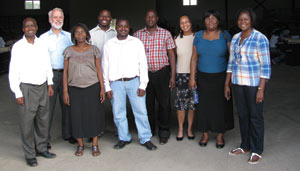Post-Enumeration Surveys in Africa
Jeremiah P. Banda, Alfredo Navarro, Rajendra P. Singh, and David C. Whitford

Pali Lahohla, statistician-general of Stats South Africa, presents a completed (and adjusted) 2011 census to President Jacob Zuma.
The UN Statistical Commission recommends that post-enumeration surveys (PES) be undertaken to measure the coverage of a census. In the 2010 round of censuses, some counties in Africa not only followed this recommendation, but enlisted PES/census “experts” to assist.
In South Africa, the PES is used to adjust for the undercount, so Statistics South Africa implemented it carefully. For instance, aerial photos were used to more clearly delineate sampled housing units to be interviewed in the PES. And, to evaluate the matching of the PES interviews to the census, a sample of areas was “rematched”; the results showed that the matching was statistically reproducible. Subsequently, the undercount was estimated and the census counts were adjusted accordingly. The adjusted official census counts were disseminated about one year after census day.
The Zimbabwe National Statistics Agency (ZIMSTAT) conducted its fourth census since independence in August 2012. Since the census data usages have increased significantly over the years, the ZIMSTAT considered it critical to evaluate the census data quality. One of the evaluation methods employed is the post-enumeration survey. This is the first time ZIMSTAT is implementing a PES. The goal of the evaluation is to understand the census data quality with respect to coverage and content errors at the national level and gain insight to improve future censuses. However, the PES is designed to account for urban/rural variation in coverage. The PES data collection was completed in November of 2012. Matching and estimation processes are planned for early 2013, and the PES evaluation is expected to be completed by mid-2013.
Ghana successfully conducted a PES following the 2010 Population and Housing Census. The objective was to measure census coverage and content error. Issues also were identified requiring improvements in future censuses. A representative sample of enumeration areas (EAs) was selected. All households and persons in the selected EAs were to be enumerated. Inferences were made at national and regional levels. Initial matching was followed by reconciliation visits, after which the final match status of all cases was established. The Dual System Estimation methodology was adopted and implemented. The results of the PES were not used to adjust census results.
Other than conducting the census, one of the highest priorities for the Zambia Central Statistical Organization (CSO) is developing and implementing a comprehensive evaluation of census data quality. The first PES was conducted right after the 1990 census. After the 2000 census, a PES was implemented, but the results failed to meet minimum quality standards and the CSO decided against releasing the results.
Following the recent 2010 census, a PES was implemented. This time, the PES execution plan included getting assistance from the U.S. Census Bureau through the Agency for International Development. Census Bureau assistance was provided through the planning and implementation of early PES operations such as clerical and computer matching. Subsequently, the focus shifted to increasing capacity through training, especially software and statistical knowledge.
The capacity-building mission focused on the design and implementation of efficient methods for handling missing data (imputation), dual-system and small-area estimation, and the estimation of reliability measures (variance estimation). Training was focused on increasing statistical knowledge and the development of statistical software, mainly desktop applications in SAS. The PES evaluations and reports are expected to be completed by the spring of 2013.
In all four of these efforts, countries not only produced high-quality censuses, but also, in accordance with UN guidelines, evaluated their products—two worthy goals of large-scale statistical endeavors such as taking censuses.


















